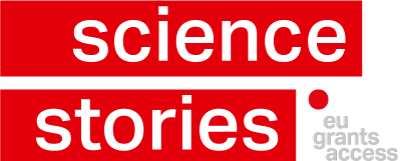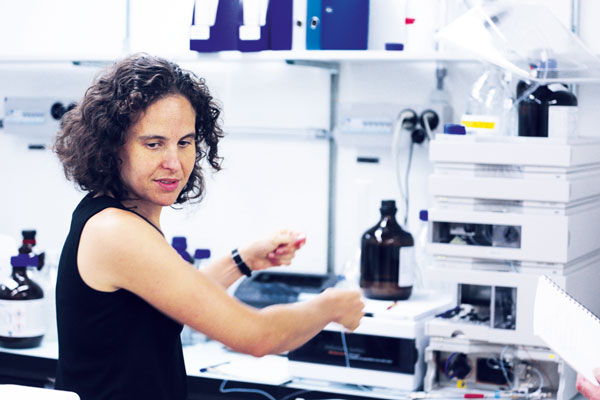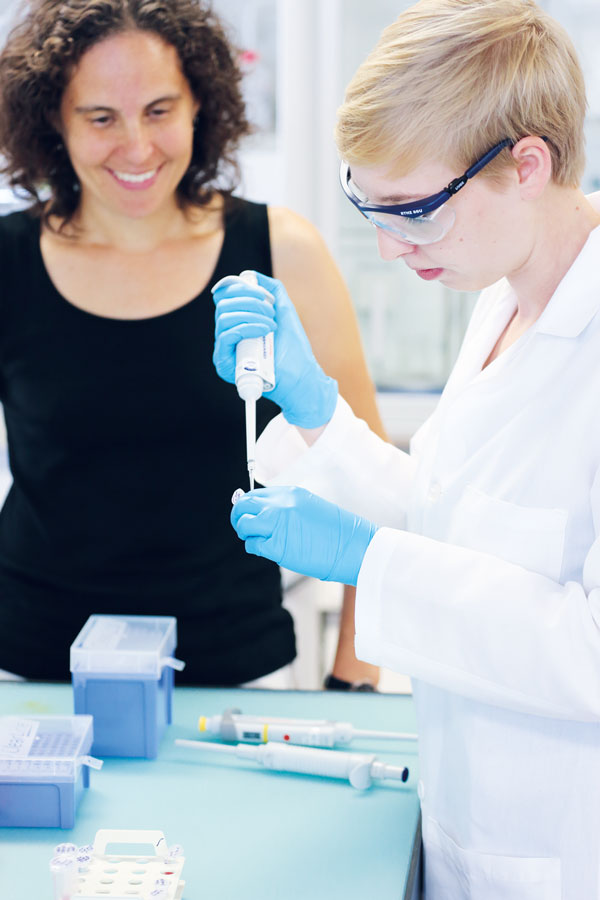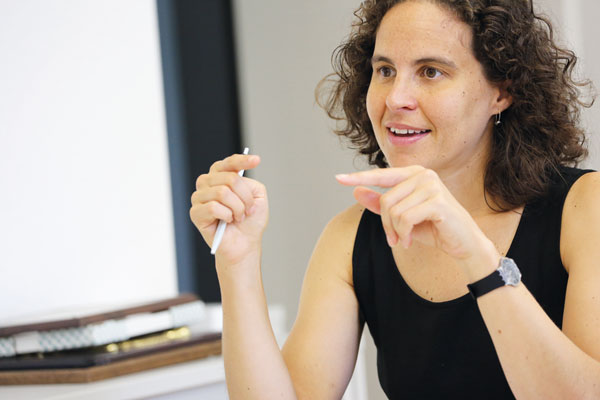
Encounter with Shana
Predicting the risk of cancer
Chemicals in our diet can induce cancer. Shana Sturla is after the suspects. She is Professor of Food and Nutrition Toxicology at ETH Zurich and examines the complex molecular mechanisms that lead to the disease. Now she has found a new approach and is developing a tool to detect the damage at a very early stage. This might open the way for risk prediction and prevention. An encounter with the young scientist to talk about her research and her experience with ERC Grants.
She welcomes us with a cheerful smile when we enter her office in her lab at ETH Zurich. Shana Sturla already had a busy morning with a series of demanding meetings before we arrive. The paper for a science journal had to be re-edited with her senior scientist, the data of an experiment needed discussing with PhD students, the application for a new spectrometer had to be specified with her technician and speakers for an international conference had to be appointed by her and a professor colleague. To run a research lab of 26 staff members including 10 PhD students is quite demanding and requires a good deal of strategic planning and management as well as scientific creativity. The young American scientist Shana Sturla is obviously gifted in both of these fields. Six years ago, when she became Associate Professor of Food and Nutrition Toxicology at ETH Zurich, she started to build up her lab here. At the same time, she applied for an ERC Starting Grant and to her own surprise, she received it.
«The ERC Starting Grant
really injected a big start
into establishing the research
programme in our lab.»
Shana still remembers the moment that was so crucial for her career: “I got this ERC Grant as I came to Europe. I applied for it before I started my position at ETH and the grant really injected a big start into establishing the research programme. It allowed us to integrate several new team members, some who had come from the United States and some we newly added when I came to Europe. So the ERC Starting Grant offered me a great chance for a good start.” She grabbed the opportunity and set out for an ambitious goal. Financed by the ERC Grant, she intended to develop a completely new strategy to explore the chemical damage in human DNA that can finally lead to cancer. The disease seems to be triggered by a minor change in the DNA of a person, which can be induced by smoking tobacco or by consuming foods like cured meats. Some of their chemical substances react with the building blocks of a cell’s DNA creating so-called DNA adducts. Up to now, it has been quite complicated and costly to detect them. But through their ERC project Shana and her team succeeded to find a new way to study DNA adducts. The project has just been completed when we meet Shana and she is more than happy with the outcome: “We made two important findings. In one way we created a new chemical approach to study the DNA damage. And using this approach we learned a lot of fundamental processes that control how an exposure to a chemical could then disrupt the biochemical machinery. And at the same time we realised that what we have on hand were new tools that could allow us to detect the chemical damage that is formed upon exposure to toxins.” So her findings not only open a better scientific understanding of the processes which are at the very beginning of cancer but also are the key to new tools for further basic research as well as for future diagnostic strategies.
From basic research to a practical tool
Having realised this potential, in spring 2015 Shana Sturla applied for an ERC Proof of Concept Grant and she got it. She explains us what she would like to prove with this Grant: “Within the ERC Starting Grant project we had a result from which we developed a new probe that allowed us to detect damaged DNA bases within particular gene sequences. We could show this worked in experiments with model systems of synthetic samples. With the ERC Proof of Concept project, we will now work with real biological samples and see if our method works there as well.” The target will be colorectal cancer and the biological samples will come from patients undergoing a routine check-up. Therefore, Shana and her team will collaborate with gastroenterologists. It is a small team of two scientists who will run this project within the next one and a half years and they have just started when we meet Shana.
«At the same time we realised
that what we have on hand
were new tools that could allow
to detect the chemical damage
that is formed upon exposure
to toxins.»
“Let’s have a look into the lab”, she suggests and leads us across the corridor. When we enter the lab, Céline Stäuble (photo on p. 4), Shana’s newly employed PhD student, is busy to prepare probes and calibrate the assay. Much preparation is needed before the team can begin to test if the probe also works with real biological samples. Céline Stäuble will do these experiments, while Shana and Ioannis Trantakis (photo on p. 4), the senior scientist who made the original discovery in the ERC project, will supervise the research and refine the commercialisation plan. Shana intends to meet two goals by means of this project: First, to develop an assay that can be commercialized. For this purpose she collaborates with an ETH
spin-off company, which is producing the nanoparticles needed for the probe. And secondly, she would like to position the probe to be used on a large scale for prediction. “The medical community thinks a lot about early diagnosis, but at that stage the disease has already developed. What we would like to do is to take our knowledge of how the disease initiates and use it as a prognostic marker of an individual’s possibility for developing the disease”, Shana explains. And she has a very clear vision of the concrete result of her ERC Proof of Concept: “The result we hope for will be a product with which the damage can be detected in biological samples. This product will be very attractive for researchers in the field of epidemiology who do large scale investigations in people having particular diets or treated with particular drugs. Here, the product could help the scientists to detect damage in the DNA caused by food or drugs. And then, as a result of their data together with the availability of biomonitoring tools, we think we can shift the paradigm from early diagnosis to early risk prognosis.” If Shana Sturla succeeds in reaching this goal, her ERC projects would turn out to be a keystone on the way to develop robust risk predictions of cancer and invest in prevention.
«What we would like to do
is to take our knowledge of
how the disease initiates and use
it as a prognostic marker
of an individual’s possibility
for developing the disease.»
Back in her office, we ask Shana how she managed to apply for ERC Grants so successfully, even at the time when she was a newcomer. “I got support from the
EU GrantsAccess Office of ETH and the University of Zurich, especially in the initiation phase but also during other steps”, she answers. “If I didn’t have the
EU GrantsAccess Office, I wouldn’t know the next requirement to keep agreements on track and get the funding coming in.”
«I would recommend that all new scientists
who are at the stage I was
when I joined ETH six years ago
should apply for an ERC Grant.»
Before we say goodbye to Shana we want to know what she, based on her experience, would advise her younger colleagues regarding ERC funding. “I would recommend that all new scientists who are at the stage I was when I joined ETH six
years ago should apply for an ERC Grant. They are at a stage of their career where they have a solid foundation of working independently and probably have a big idea for what to do next. An ERC Grant will help them to realise this idea”, Shana says with a bright smile and rushes off to the next meeting.
A new approach and a tool to detect DNA adducts
The onset of cancer is characterised by a minor change in a person’s genetic material. A cell’s DNA mutates in a particular area to the extent that the cell no longer divides in an orderly manner, but begins to grow uncontrollably. In many cases, this type of genetic mutation involves chemical changes to individual building blocks of DNA. These changes can be induced by smoking tobacco or consuming foods such as cured meats. This is because the contents of these materials can chemically react with and change building blocks of cellular DNA, thereby creating DNA adducts. Financed by the ERC Starting Grant, Shana Sturla and her team have succeeded for the first time in amplifying gene samples containing DNA adducts while retaining references to these adducts. This type of amplification is a prerequisite for the majority of technologies used by researchers to determine a gene’s DNA sequence. In the future, it may therefore be possible to expand DNA sequencing from the four basic DNA building blocks to include adducts. The scientific community would have an important tool for providing a detailed analysis of the molecular mechanisms involved in the initiation of cancer and the corresponding risk factors.
The results which Shana Sturla and her team achieved are based on experiments with models for which the molecules were produced synthetically in the lab. The ERC Proof of Concept Award now opens the chance to test whether this probe developed on a model base also works with readily obtained biological samples. If the tests are successful, a tool would be developed which can be used for personalized exposure evaluation and risk prediction.
Source: ETH News 15 January 2015
https://www.ethz.ch/en/news-and-events/eth-news/news/2015/01/damaged-dna-amplified.html
Interview with Shana Sturla
Shana Sturla
Shana Sturla has led the Laboratory of Food and Nutrition Toxicology at ETH Zurich since November 2009, and is a Tenured Associate Professor. She earned a degree in Chemistry from the University of California at Berkeley in 1996 and a PhD from the Massachusetts Institute of Technology in 2001. Following postdoctoral research at the University of Minnesota Cancer Center, she joined the faculty of the University of Minnesota, where she was an Assistant Professor from 2004 to 2009. She received a National Cancer Institute Career Development Award (2004) and the American Chemical Society Young Investigator in Toxicology Award (2014). The goal of her research is to understand how chemicals, such as diet-derived natural products or derivatives, impact disease incidence and treatment. Knowledge regarding molecular mechanisms of toxicity that will be gained from this research is expected to contribute to improved human health and disease prevention strategies.
European Research Council (ERC) Grants
Shana Sturla received an ERC Starting Grant in September 2010 of 1.5 million Euros for her project “DNA Adduct Molecular Probes: Elucidating the Diet-Cancer Connection at Chemical Resolution”. The project ended in August 2015. In spring 2015, she was awarded an ERC Proof of Concept Grant of 150,000 Euros for the project “A Hot-Spot Bio-Barcode Strategy for Prognostic Biomarkers in Colorectal Cancer”.





